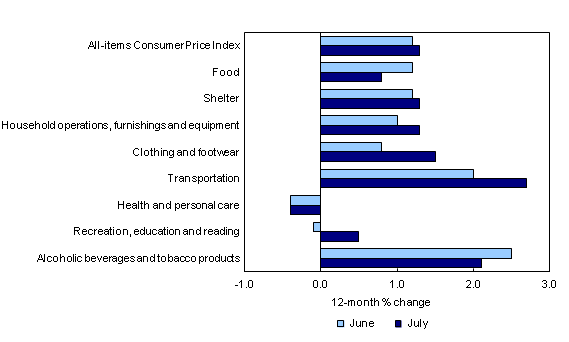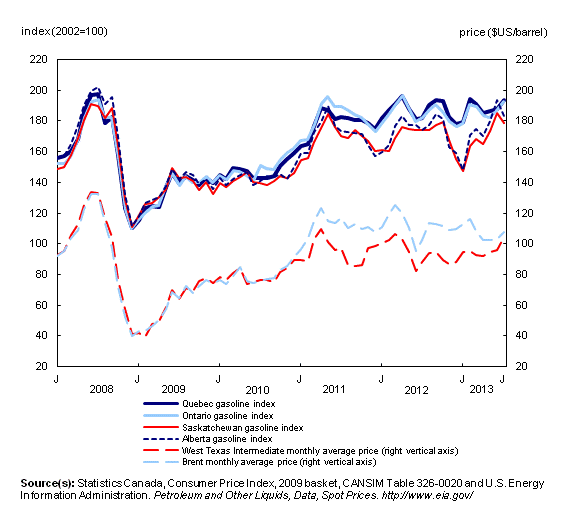Consumer Price Index, July 2013
Archived Content
Information identified as archived is provided for reference, research or recordkeeping purposes. It is not subject to the Government of Canada Web Standards and has not been altered or updated since it was archived. Please "contact us" to request a format other than those available.
Released: 2013-08-23
The Consumer Price Index (CPI) rose 1.3% in the 12 months to July, following a 1.2% increase in June.
The increase in the CPI in July was led by transportation prices, which rose 2.7% on a year-over-year basis, following a 2.0% gain in June.
Compared with July last year, consumers paid 6.1% more for gasoline. This followed a 4.6% increase in June. Gasoline prices rose in all provinces, with Prince Edward Island (+13.9%) recording the largest gain and Saskatchewan (+2.7%) posting the smallest increase.
Prices for the purchase of passenger vehicles rose 2.0% in the 12 months to July, matching the increase in June.
12-month change in the major components
In addition to transportation, the shelter component was a main upward contributor to the increase in the CPI in July. At the same time, the food index posted its smallest year-over-year increase in over three years. The index for health and personal care was the only major component to record a decline in July.
Shelter costs rose 1.3% in the 12 months to July, after increasing 1.2% in June. Compared with July last year, natural gas prices and rent increased, while mortgage interest cost declined 3.8%.
Food prices rose 0.8% in the 12 months to July, following a 1.2% advance in June. The July increase was the smallest gain in food prices since June 2010. The cost of food purchased from stores rose 0.5% in the 12 months to July, a smaller increase than in June (+1.3%). Prices for fresh fruit, fresh vegetables and meat all increased less in July compared with June.
Conversely, prices for food purchased from restaurants advanced 1.5% on a year-over-year basis in July, following a 1.1% increase in June.
The health and personal care component decreased on a year-over-year basis for the fourth consecutive month in July. These declines followed more than a decade of price increases. The recent declines are mainly attributable to falling prices for prescribed medicines.
12-month change in the provinces
Consumer prices rose in nine provinces in the 12 months to July with the largest increase occurring in Manitoba. The exception was British Columbia, where prices posted no change on a year-over-year basis in July.
In Manitoba, consumer prices rose 3.0% in the 12 months to July, following a 2.7% gain in June. Manitoba posted larger year-over-year price increases for gasoline, for passenger vehicle registration fees and for cigarettes compared with the national average. On July 1, 2013, the Provincial Sales Tax in Manitoba rose from 7% to 8%.
Prices in British Columbia posted no change in the 12 months to July, after falling 0.5% in June. The province continued to post year-over-year price decreases for food purchased from restaurants and homeowners' replacement cost. Conversely, consumers in British Columbia paid 7.3% more for gasoline in July compared with the same month a year ago.
Saskatchewan and Alberta were the only two provinces where consumer prices rose at a slower year-over-year rate in July compared with June. In both provinces, prices for gasoline, for natural gas and for the purchase of passenger vehicles advanced less in the 12 months to July than in the 12 months to June.
Seasonally adjusted monthly CPI increases
On a seasonally adjusted monthly basis, the CPI rose 0.2% in July, matching the increases in May and June.
On a seasonally adjusted basis, four of the eight major components posted increases in July. The largest gain was in the household operations, furnishings and equipment component (+0.4%).
The price indexes for clothing and footwear as well as transportation posted no change in July. However, before seasonal adjustment, these indexes decreased 0.9% and 0.3% respectively. This indicates that the observed price declines for these components were largely seasonal.
The seasonally adjusted indexes for food (-0.1%) and for alcoholic beverages and tobacco products (-0.3%) were the only components to post declines.
Bank of Canada's core index
The Bank of Canada's core index rose 1.4% in the 12 months to July, following a 1.3% increase in June.
On a monthly basis, the seasonally adjusted core index increased 0.1% in July, after rising 0.2% in the previous month.
Shrinking gaps between provincial gasoline price indexes and between crude oil benchmarks
Starting in 2011, provincial gasoline price indexes began to diverge. In general, gasoline price indexes increased at a slightly faster pace in Central and Eastern Canada than in the West, resulting in a spread between some provincial gasoline indexes.
This observed spread in price indexes for gasoline is largely associated with the dual crude oil market in Canada and the price differential between the West Texas Intermediate (WTI) and Brent crude oil benchmarks.
In recent months, the divergence between provincial gasoline price indexes has disappeared. The closing of this gap between gasoline price indexes has coincided with the shrinking of the price differential between the two crude oil benchmarks.
For more information on the divergence between provincial gasoline price indexes and the dual crude oil market in Canada see "Study: Canada's dual crude oil market and the influence on changes in gasoline prices".
Note to readers
A seasonally adjusted series is one from which seasonal movements have been eliminated. Users employing CPI data for indexation purposes are advised to use the unadjusted indexes. For more information on seasonal adjustment, see Seasonal adjustment and identifying economic trends.
The Bank of Canada's core index excludes eight of the CPI's most volatile components (fruit, fruit preparations and nuts; vegetables and vegetable preparations; mortgage interest cost; natural gas; fuel oil and other fuels; gasoline; inter-city transportation; and tobacco products and smokers' supplies) as well as the effects of changes in indirect taxes on the remaining components.
For a more detailed analysis, consult the publication The Consumer Price Index. The July 2013 issue of The Consumer Price Index, Vol. 92, no. 7 (Catalogue number62-001-X), is now available from the Browse by key resource module of our website under Publications.
More information about the concepts and use of the Consumer Price Index are also available online in Your Guide to the Consumer Price Index (Catalogue number62-557-X), from the Browse by key resource module of our website under Publications.
The Consumer Price Index for August will be released on September 20.
Contact information
For more information, or to enquire about the concepts, methods or data quality of this release, contact us (toll-free 1-800-263-1136; infostats@statcan.gc.ca) or Media Relations (613-951-4636; statcan.mediahotline-ligneinfomedias.statcan@canada.ca).
- Date modified:






